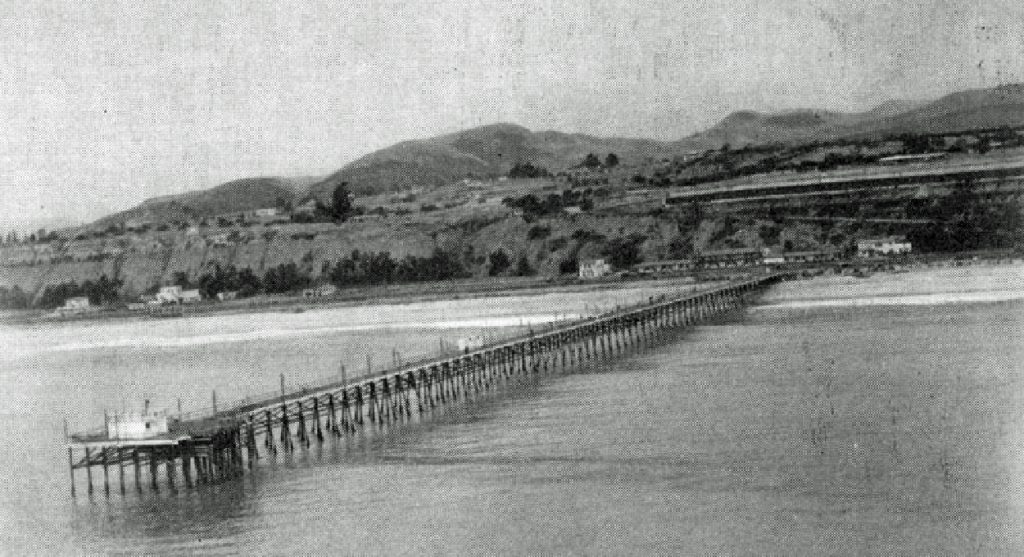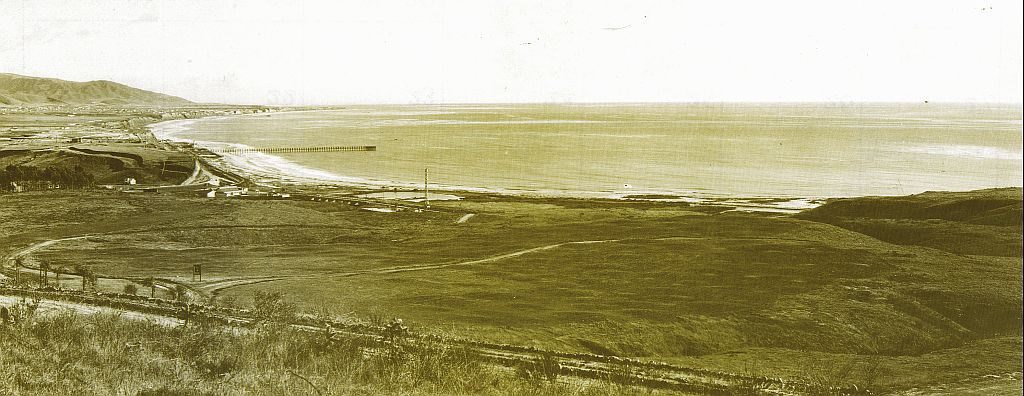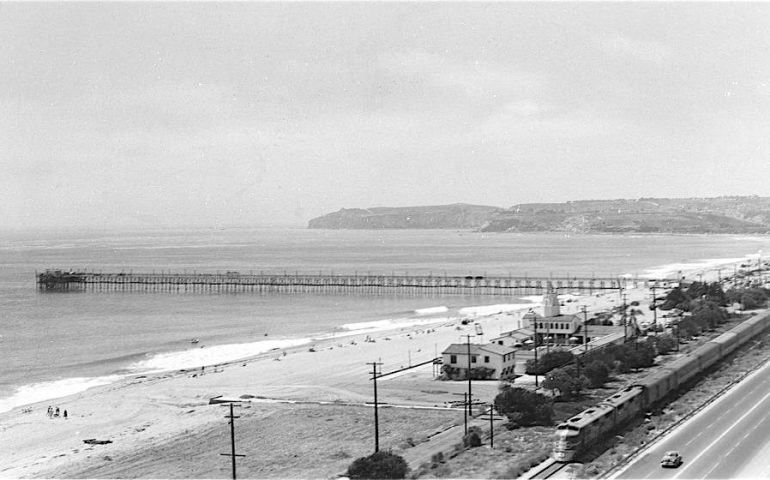For many years a large pier was located on the sandy seashore between Dana Point and San Clemente. It was the Capistrano Beach Pier, a pier built in 1929 by Edward (Ned) Doheny Jr. and the Capistrano Beach Company.
The wooden pier was 1,180 foot long and 20 foot wide until the end where anglers saw a T-shaped end that was 80 by 60 feet. The end area included a gangway that went down to a floating dock used by fishing boats and visiting yachts.
By the late 40s there were Sportfishing operations from the pier but the pier itself was also considered a good fishing pier, especially for inshore surf species. A few stories give a flavor of the pier.
Good catches of halibut, corbina and spotfin croakers are reported off of Capistrano Pier. —Fishing’ Around, Al Larson, Press-Telegram, Long Beach, California, August 10, 1947
The following story is obviously wrong as to this being the first halibut from the pier but it is not the first time a fishing story was wrong.
Hubbell Anderson has returned from a week’s visit with Mr. and Mrs. S. L. Whitt at their home in Capistrano… Anderson enjoyed fishing about every day and he established quite a record in that he caught what is reported to be the first halibut ever caught from the Capistrano pier. This was vouched for by the man who has been in charge of the pier. The much-prized halibut weighed 15 pounds. —San Bernardino County Sun, San Bernardino, California, October 1, 1952
There was good news for the surf fishermen. Corbina started hitting all along the coast…Mac Makemson of Sims Bait & Tackle on Hwy. 101 weighed in one 7 ½-pounder for Ray Henkel. Henkel and others in the party had 9 other fish ranging from 3 to 3 ½ pounds which they caught near the San Clemente Beach State Park. Mac also reported another party caught a limit off of the Capistrano Pier. —Fishin’ Around, Donnell Culpepper, Press-Telegram, Long Beach, California, July 21, 1953

Notable incidents included a plane that crashed into the water about 200 yards off the pier in July 1959. The Cessna 160 had three people aboard and for two weeks debris and body parts washed ashore. A few years later, June 1963, saw an angler who was headed to the pier being stuck by a train at the crossing near the pier.
Unfortunately the pier, like most along the coast, would see occasional damage from storms and repairs would be made. Not so following a storm in 1964 that saw waves overcome the pier footing at the beachhead. The result was severe damage and soon after the pier was deemed unsafe. It was condemned and closed to fishing.
The Cherry-Hadley Corp., which had a lease from the state at the time for its use, began to study its options and eventually it decided on an option that few wanted to hear. They decided the pier was too expensive to repair. It would have to be taken down.
In November 1965, a block A-frame structure was placed over the pier and a four-man team of underwater demolition experts began to blow up the pier in 30 to 60 foot sections (after carefully removing the pigeons that lived down around the pilings under the pier). As each section was blown up the broken pieces would be dragged ashore by the hydraulic units inside the A-frame. In time there was nothing to see but empty water.
<*}}}}}}}}}>< — CA Fish Bulletin #96 from 1953 says the following about Capistrano Beach “Located three miles east of Dana Point and a mile east of the mouth of the San Juan River. This was known as Doheny Park until 1931 when the name was changed to Capistrano Beach. There are no fish handling facilities except a good pier where boats may land catches. Several small-scale fishermen live near here and for the three years 1949–1951 delivered a yearly average of 18,000 pounds of fish, practically all abalone. Sport fishing flourishes here with a good pleasure pier and a fishing barge anchored off shore. In 1952 there were two party boats and one charter boat operating out of Capistrano Beach.”
<*}}}}}}}}}>< — “Doheny Park, 64.9m. (50 alt.) is a residential village promoted by and named for Edward Lawrence Doheny, former Los Angeles oil operator. Along the shore to the south is Capistrano Beach, with a club and modern fishing pier.” —Workers of the Writer’s Program of the Work Projects Administration in Southern California, Los Angeles, A Guide to the City and Its Environs, 1951
<*}}}}}}}}}>< — One day I asked if anyone on the message board had ever fished the Capistrano Beach Pier,
Date: August 29, 2007; To: PFIC Message Board; From: Snookie; Subject: Re: Did anyone here ever fish the Capistrano Pier?
<*}}}}}}}}}>< — Doheny became a focal point of the surfing counterculture in the 1950’s and 60’s after its name was used in the lyrics of Surfer Joe by the Surfaris, and the hit, Surfin’ USA, made famous by the Beach Boys. —Doheny Sate Beach Interpretive Association
History
The pier was built by Edward (Ned) Doheny Jr. and the Capistrano Beach Company. Ned was the son of California’s first oil baron, Edward Doheny Sr., who had made his fortune in oil production in Southern California after discovering oil in 1892 near today’s Dodger Stadium.
Edward Doheny’s corporation had purchased 1,000 acres of land in the Capistrano Beach area in 1928 but soon after the project was handed over to his son. Ned Doheny, together with several relatives. They then formed the Capistrano Beach Company, and together with contractor Luther Eldridge began to plan Doheny Park (later Capistrano Beach). Their motto for the development was “Birth of a City” although today the area is part of Dana Point.

Apparently borrowing some ideas from Ole Hansen in San Clemente, the plan was to build to build a community of Spanish style houses on the beach and on the Palisades up above. Eldridge’s plan included laying out the streets in curves and planting palm trees, so that the community would resemble a rose. The red tile roofs were to be the petals, and the trees the leaves.
By early 1929 Eldridge had been able to complete the original Doheny family house on the bluffs, four houses on the beach, and 18 other homes scattered throughout the area when the project came to a screeching halt.
On February 16, 1929, while Edward Doheny Sr. was busy preparing for his criminal trial for bribery in the historic Teapot Dome Scandal, tragedy struck. Ned Doheny and Hugh Plunkett, his friend and secretary, and both scheduled to testify in the trial, were killed in a murder at Ned’s Greystone Mansion in Beverly Hills. The murder remains unsolved to this day. Many at the time believed Ned was killed by his crazed secretary, who then killed himself. Some felt it was Doheny who murdered Plunkett before committing suicide.
Important to our story, before his death Ned Doheny and Eldridge had made plans for three projects that would soon be finished. All would become local landmarks— the Capistrano Beach Club, a gazebo, and the Capistrano Beach Pier.
New Pleasure Pier Started at Capistrano
Plans for a $50,000 pleasure and fishing pier for Capistrano Beach have been completed and construction was started this week, according to James E. Appleby, director of sales for Walles-Smith Company, managers and developers of the beach city. — Los Angeles Times, March 3, 1929
Unfortunately the pier would only survive a little over a third of a century since it was demolished in 1965. However, the Doheny name is still important in the area because of the Doheney Beach.
On May 31, 1931, as a memorial to his son Ned, the Petroleum Securities Company, Doheny’s family-owned business, made a gift of 41.4 acres of prime ocean front property to the State of California. The land, valued at $1 million, would become Doheny State Beach Park, California’s first state beach.
By 1944 the park was taking in the most revenue of any campground in the state park system and in 1955 the pier and its beach was added to the park. On July 1, 1963, it was renamed Doheny State Beach. The original 41 acres were augmented over the years with an additional 21 acres by acquisitions from the Santa Fe Railroad, University of California Regents, and the Union Oil Company. Today, Doheny’s 122 camping spaces remain the most popular in the State.

Wonderful story. I love to read California history. I have been a resident since 1963. The insight from such, to me, little known history is so nostalgic. Not having been raised in California I was not aware of a lot of these things although I am familiar with most of the more famous names.
I too love history and when combined with my love of piers it sometimes yields an interesting story or two.
What would be the exact location of the old pier?
I remember the name of the two boats that ran out of the Capistrano pier one the Ramona was a day boat and the other was called the Pali which was an overnight that chased Albacore I also fished off the barge there was a taxi boat that would drop you off at the barge and pick you up I’m not sure if it ran every hour or two the barge had a live bait tank fishing was good lots of White Sea bass my uncle Bob Clark ran the pier late florties and early fifties I think I used to stand on the pier and watch people dive for abalone this was like 1951 or 52 good times
It is one of the piers that I wish I had fished.
In the late summer of 1959 I worked for lobster fisherman Woody
Payne dipping his traps in tar then stacking them on the end of the Capistrano Beach
Pier prior to the opening of the commercial lobster fishing season.
The pier was in such sad shape Woody made me get out of his pickup and walk beside it because he was concerned the weight of the truck and traps might collapse under us
At that time a local we nicknamed “Dead Eye” lived under the pier at the end.
That’s Wilson “Bogey” Bogan and Davie Rutan with the Black Sea Bass. They probably took it off of Joe Patterson’’s boat, the Lot’a Fun
but I can’t guess why they’d land it at Capo Beach. Joe held the world’s record for Blacks (before the moratorium) in 1957., and may hold it yet.
Bobby Miller was the last guy to live on the pier before it was demolished.
Deadeye was an obsessed fisherman who went out all the time with Doug Fredericks. They both seemed simple-minded, but they caught a lot of fish, and stayed alive, even with jaunts to San Clemente Island in a fifteen foot skiff.
Dion Wright